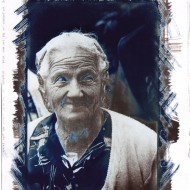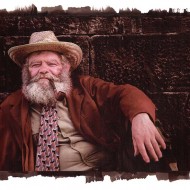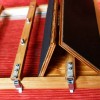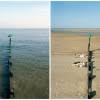Lots of Van Dyke Brown printers lament that a precipitate form inside a Van Dyke Brown solution, obtained during the preparation of the solution itself, or more precisely just before finishing to add C inside A+B, following the conventions and quantities of the VDB classic formula like the Wynn Whyte style says.
Not everyone obtains this precipitate and the principal reason is that ammonium ferric citrate is not a well-defined chemistry substance. (go to Mike Ware page for same examples), that means it changes from distributor to distributor and often from bottle to bottle.
VDB precipitate description
The precipitate I obtained, which has an aspect similar to the one described by many other printers, has a light grey-green color, a milky aspect, as it would be a suspension of fine grey powder. Just to let you understand, it has a color similar to mustard mixed with oil. Once obtained a homogeneous cream, in a ten-minute the oil starts separating from mustard and the visual aspect is, apart from the color, similar to the one obtained with VDB solution.
The precipitate is obtained when 2/3 of C solution has been added to A+B. Suddenly a precipitate takes form, in big quantities, as solution would have reached a saturation point and adding an only drop of C would bring immediately to the precipitate we were talking about. No matter if you mix more slowly, no matter if you let the agitator on for hours: the precipitate is formed and you can’t dissolve it anymore.
If you let the bottle aside, the precipitate settles on the bottom, occupying a volume that is almost the half of the entire solution. Agitating the bottle gives an opaque solution that produces an irregular, granular, maculated and black streaked print. Using the solution on the top of the precipitate, the print is correct, but the volume of solution we could use would only be the 50%. Analogously, filtering the solution means losing a big volume of salts, potentially composed of silver that, if inside solution, could be used to form the image. As the silver nitrate is expensive, it would be better to avoid this settle.
Other settlements in Van Dyke Brown solutions
This precipitate has not to be confused with other settlements obtained in Van Dyke Brown Solutions. It has nothing in common with “silver plating”, which is a fine film of metallic aspect, such a thin mirror. This film settles on the inner surface of the bottle or of the emulsion surface if it’s let at rest for some weeks. It has also nothing in common with the fine precipitate that settles on the bottom of bottles after some days, generally a poor quantity of fine dark green powder. These two types of precipitate usually interest a little percentage of the solution and do not cause problems during the print.
There’s no solution on how to avoid them, if it’s better filtering the solution or collecting the clearer solution near the surface and leaving the other part where it is or again shaking the bottle before using. There’s no match exactly because the ammonium ferric citrate is different for every printer. Sometime shaking augments print dmax, but also add an unpleasant grain; filtering can augment and decrease print contrast, change tones; etc, etc… In general some attempts are necessary to determine which one is the most convenient procedure. Once determined the method, it is easy to keep a constant standard.
In every case this kind of precipitate, with prudence, has a poor impact on print and do not cause a large lost of salts.
The precipitate we’re talking about has nothing in common even with the white suspension obtained when C is added too quickly in A+B solution. If you energetically mix the obtained solution, this suspension goes easily back in solution. If you did add too quickly the C solution, a completely insoluble gritty settlement takes form.
In every case I always added C in A+B solutions with a lab agitator and a burette regulated for about a drop every second.
Remedy for precipitate inside VDB solutions
Augmenting the concentration of the tartaric acid inside B solution helps avoiding this settlement.
Tartaric acid can also be added in a classical solution that already contains the settlement; in fact, mixing the settlement gives the solution back.
The first time I made this attempt, I added 0.5g of tartaric acid inside the classical solution with the settlement until it completely disappeared. Adding 2.5g of tartaric acid, the settlement disappeared, but the solution had an opaque and absolutely not transparent aspect. Adding some more tartaric acid didn’t turn it transparent; therefore I imagine that this suspension is a different from the original one. Once it is at rest at the bottom of the bottle, a fine and dark powder settle in small quantities that can be easily filtered. Either the solution can be shook before using; in both cases the result is a correct print, without streaks or grains.
This experience brought me to modify the classical VDB solution to focus on the one I identify as VDB2, which is a solution with 4g of tartaric acid instead of the classical 1.5g.
VDB2 characteristics
The obtained solution is more contrasted and it has a higher dmax compared to the classical one. Its hue seems the same, even if this one is controlled by some other variables such as the paper humidity.
A big difference is that there’s no more printing out, but paper develops during the first washing. When the exposition is visually controlled, this can modify your own habits, to the detriment of a strong overexposure, but it is still easy to determine the correct exposition after some test prints.
Conclusions
The usage of VDB2 formula, in my case and with my ammonium ferric citrate, allows deeper and more contrasted prints than those obtained with VDB classical formula. The image is anyway similar to the one obtained with Wynn White’s VDB solution, but the huge advantage is that you can use the entire solution and not only the 50%. It is a considerable economical benefit.



































You can also subscribe to this post comments RSS feed.